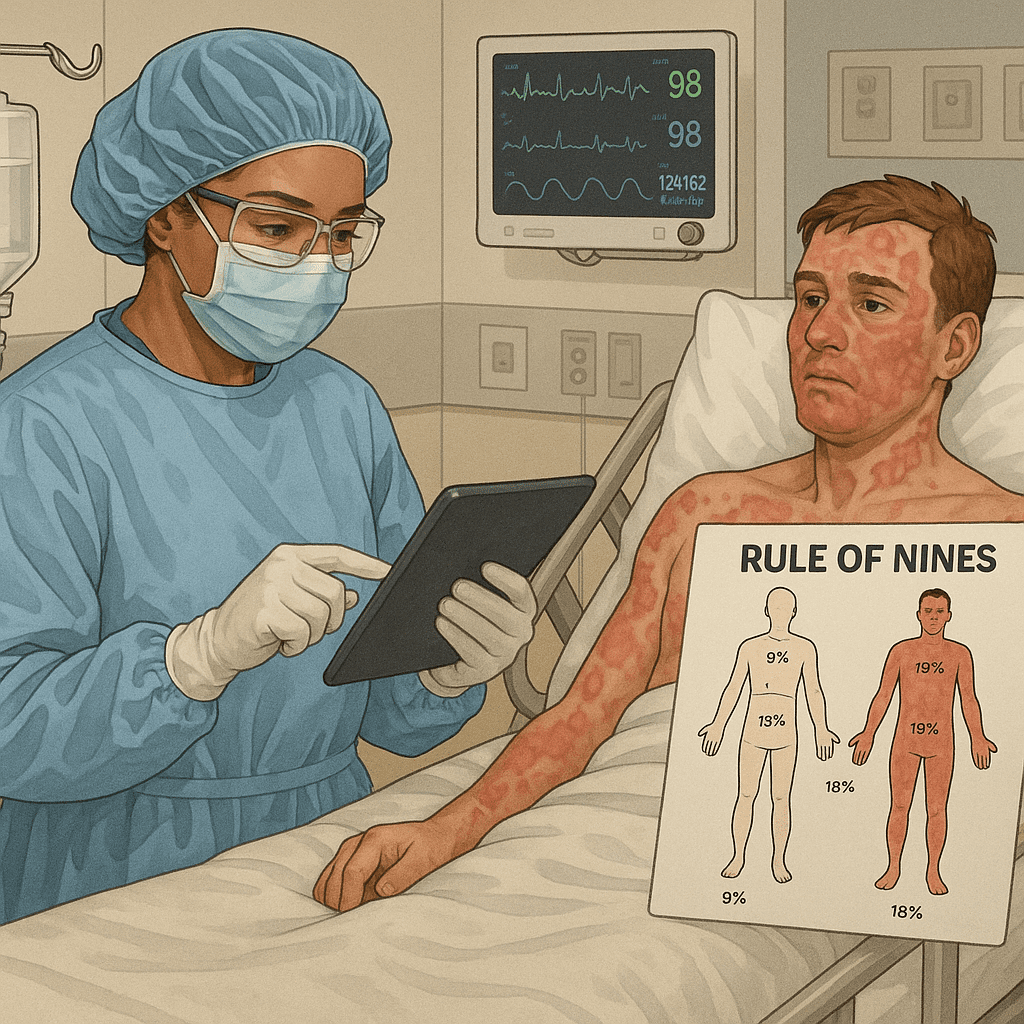🧠 Introduction
Burn injuries are among the most critical conditions nurses encounter, requiring rapid assessment and precise interventions. For any RN nurse or registered nurse preparing for the NCLEX, mastering the Rule of Nines and fluid resuscitation principles is essential. This guide simplifies burn assessment and management, helping nursing students and professionals apply evidence-based care confidently.
🔥 Understanding Burn Classification
Before calculating fluids or determining the extent of injury, the nurse must understand burn classifications based on depth:
- Superficial (First-degree): Involves only the epidermis. Skin is red and painful, like a mild sunburn.
- Partial-thickness (Second-degree): Involves the dermis. Blisters, moist surface, and severe pain are common.
- Full-thickness (Third-degree): Destroys all skin layers. The area may appear white, leathery, or charred, and pain may be absent due to nerve damage.
Knowing the burn depth helps the nurse plan interventions, anticipate complications, and monitor healing.
📏 The Rule of Nines Explained
The Rule of Nines is a quick method for estimating the total body surface area (TBSA) affected by burns in adults. This is critical for fluid resuscitation and predicting patient outcomes.
| Body Region | Percentage (%) |
|---|---|
| Head and Neck | 9% |
| Each Arm | 9% |
| Each Leg | 18% (front 9%, back 9%) |
| Anterior Trunk | 18% |
| Posterior Trunk | 18% |
| Perineum | 1% |
🩺 Example for NCLEX:
If a patient has burns on the entire anterior torso and one arm, the total burn area is 18% (torso) + 9% (arm) = 27% TBSA.
This calculation helps the registered nurse determine how much IV fluid the patient needs in the first 24 hours after injury.
💧 Fluid Resuscitation: The Parkland Formula
Fluid resuscitation is vital to prevent hypovolemic shock in burn patients. The Parkland Formula is used to calculate the required fluid volume:
![]()
Administration Guide:
- Give ½ of the total volume in the first 8 hours post-burn.
- Give the remaining ½ over the next 16 hours.
💡 Example:
A 70 kg adult with 30% TBSA burns:
4 × 70 × 30 = 8,400 mL total fluids
- 4,200 mL in the first 8 hours
- 4,200 mL over the next 16 hours
The nurse must monitor urine output (≥ 0.5 mL/kg/hr) to ensure adequate perfusion.
⚕️ Nursing Responsibilities in Burn Care
As part of nursing practice, the RN nurse plays a crucial role in the following areas:
1. Initial Assessment
- Use the Rule of Nines for quick TBSA estimation.
- Assess airway—especially if the burn involves the face or neck.
- Monitor for carbon monoxide poisoning and inhalation injury.
2. Fluid Management
- Start IV access immediately (preferably with two large-bore IVs).
- Administer fluids according to the Parkland formula.
- Monitor urine output, vital signs, and electrolytes.
3. Pain Management
- Administer IV opioids as ordered.
- Avoid IM injections—they may be ineffective due to poor tissue perfusion.
4. Wound Care
- Use sterile technique during dressing changes.
- Watch for signs of infection.
- Provide emotional support and patient education on healing and scar care.
🧩 NCLEX Nursing Tips
For NCLEX questions related to burns, remember these key points:
✅ Airway is always the first priority, especially with facial or neck burns.
✅ Use Rule of Nines only for initial estimation; detailed charts may follow in hospital care.
✅ Apply the Parkland formula using TBSA and weight.
✅ Monitor for electrolyte imbalances (especially sodium and potassium).
✅ Expect increased hematocrit and BUN due to fluid loss.
💡 Final Thoughts
Understanding the Rule of Nines and fluid resuscitation equips every nurse and registered nurse with the tools to make rapid, life-saving decisions. These topics are frequently tested on the NCLEX, making them a must-know for anyone using a nursing bundle or preparing for clinical practice. In burn management, precision, timing, and teamwork save lives.
🔍 FAQs: Burns, Rule of Nines, and Fluid Resuscitation for Nurses
The Rule of Nines is a quick method nurses use to estimate the total body surface area (TBSA) affected by burns. It divides the body into regions that represent 9% (or multiples of 9%) of TBSA. This calculation helps registered nurses (RN nurses) determine the severity of burns and calculate fluid resuscitation needs — a key step in emergency care and NCLEX preparation.
On the NCLEX, questions about burns often test your ability to calculate TBSA accurately and apply the Parkland formula for fluid resuscitation. In clinical nursing, this method helps determine how much fluid a patient needs in the first 24 hours to prevent hypovolemic shock, making it a lifesaving nursing skill.
The Parkland formula calculates how much IV fluid a burn patient requires:![]()
Half of the total fluid is given in the first 8 hours, and the rest over the next 16 hours. The nurse monitors urine output (≥ 0.5 mL/kg/hr) to evaluate hydration and kidney perfusion — a common NCLEX nursing concept.
The recommended fluid for initial burn resuscitation is Lactated Ringer’s (LR) solution. It closely mimics plasma electrolyte composition and helps prevent metabolic acidosis. Registered nurses and nursing students should remember that normal saline is not the first choice for large burn fluid replacement due to chloride overload.

